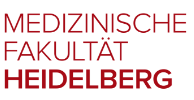
Prof. Dr. med. Peter Schirmacher
Ärztlicher Direktor
(Allgemeine Pathologie und Pathologische Anatomie)
Geschäftsführender Direktor
(Pathologisches Institut)
Mitglied
(Use & Access Commitee)
Co-Director
(Translational Spatial Profiling Center (TSPC))
Ärztlicher / Beruflicher Werdegang
- seit 2004
Professor of Pathology (C4) and Director, Institute of Pathology, Heidelberg
- 1998 – 2004
Professor of Pathology (C3), Deputy Director, Institute of Pathology, Cologne
- 1996
Board Certification Molecular Pathology
- 1995
Board Certification Pathology
- 1991 – 1998
Research Associate, Institute of Pathology, University of Mainz
- 1989 – 1991
Postdoctoral Research Fellowship (DFG); Liver Research Center, Albert Einstein College of Medicine, New York
- 1987 – 1989
Research Associate, Institute of Pathology, University of Mainz
Wissenschaftlicher Werdegang
- 1996
Habilitation (Pathology), University of Mainz
- 1989 – 1991
PhD-Study (Molecular Biology), Liver Research Center, Albert Einstein College of Medicine, New York
- 1987
MD-Thesis, Institute of Physiology, University of Mainz
- 1981 – 1987
Study of Medicine, University of Mainz
Auszeichnungen
- seit 2012
Member of the Leopoldina, German National Academy of Sciences
- 1997
Boehringer Ingelheim Award
- 1987
Johannes Gutenberg Award
Mitgliedschaften
- seit 2015
Since 2015 Board member European Society of Pathology (ESP)
- seit 2015
Board member National Center of Tumor Diseases (NCT)
- seit 2014
Board Member German Telematics Platform (TMF
- seit 2013
Board Member International Liver Cancer Association (ILCA)
- seit 2011
Board Member German Liver Foundation
- 2008 – 2016
Member and Speaker (2008-2012) of Section 2 (Cancer and Stem Cell Research), German Research Foundation (DFG)
- 2007 – 2009
Board Member German Association for Study of the Liver (President 2008-2009)
- seit 2007
Board Member German Association of Pathology (DGP)
Ämter und Funktionen
- seit 2013
Chairman German Society of Pathology
- 2012 – 2013
President German Society of Pathology
- 2011 – 2012
President International Laennec Society of Liver Pathology
- seit 2011
Founder and Coordinator of the centralized BiomaterialBank Heidelberg BMBH
- seit 2011
Principle Investigator and Coordinator of Biobanking Platforms, GermanConsortium for Translational Cancer Research (DKTK) and German Center for Infectious Diseases Research (DZIF)
- 2010 – 2014
Coordinator of the SFB/TR77 “Liver Cancer” (DFG)
- seit 2006
Co-Founder and Speaker of the Advisory Board 'Tissue Imaging and Analysis Center’ (TIGA), Heidelberg
- seit 2005
Founder and Speaker ‘Tissue Bank of the National Center of Tumor Diseases
- seit 2005
Founder and Speaker ‘Working Group Tissue Banks of the German Cancer Centers’
- 2004 – 2010
Managing board Tumorzentrum Heidelberg/Mannheim
- 2001 – 2004
Managing board ‘Center for Molecular Medicine Cologne’ (CMMC)
- 1996 – 1998
Managing board DFG-SFB 519
Selected Publications
1. Mogler C, König C, Wieland M, Runge A, Besemfelder E, Komljenovic D, Longerich T, Schirmacher P, Augustin HG. (2017) Hepatic stellate cells limit hepatocellular carcinoma progression through the orphan receptor endosialin. EMBO Mol Med. 9(6):741-749
2. Gdynia G, Sauer SW, Kopitz J, Fuchs D, Duglova K, Ruppert T, Miller M, Pahl J, Cerwenka A, Enders M, Mairbäurl H, Kamiński MM, Penzel R, Zhang C, Fuller JC, Wade RC, Benner A, Chang-Claude J, Brenner H, Hoffmeister M, Zentgraf H, Schirmacher P, Roth W. (2016) The HMGB1 protein induces a metabolic type of tumour cell death by blocking aerobic respiration. Nat Commun 7:10764. (Publication received the Novartis Award 2016 and the Landesforschungspreis Baden-Württemberg 2016)
3. Ploeger C, Waldburger N, Fraas A, Goeppert B, Pusch S, Breuhahn K, Wang XW, Schirmacher P, Roessler S (2016) Chromosome 8p tumor suppressor genes SH2D4A and SORBS3 cooperate to inhibit interleukin-6 signaling in hepatocellular carcinoma. Hepatology 64(3):828-42.
4. Samarin J, Laketa V, Malz M, Roessler S, Stein I, Horwitz E, Singer S, Dimou E, Cigliano A, Bissinger M, Falk CS, Chen X, Dooley S, Pikarsky E, Calvisi DF, Schultz C, Schirmacher P, Breuhahn K. (2016) PI3K/AKT/mTOR-dependent stabilization of oncogenic far-upstream element binding proteins in hepatocellular carcinoma cells. Hepatology 63(3):813-26.
5. Rudalska R, Dauch D, Longerich T, McJunkin K, Wuestefeld T, Kang TW, Hohmeyer A, Pesic M, Leibold J, von Thun A, Schirmacher P, Zuber J, Weiss KH, Powers S, Malek NP, Eilers M, Sipos B, Lowe SW, Geffers R, Laufer S, Zender L (2014) In vivo RNAi screening identifies mechanisms of Sorafenib resistance in liver cancer. Nat Med 20(10):1138-46.
6. Pellegrino R, Calvisi DF, Neumann O, Kolluru V, Wesely J, Chen X, Wang C, Wuestefeld T, Ladu S, Elgohary N, Bermejo JL, Radlwimmer B, Zörnig M, Zender L, Dombrowski F, Evert M, Schirmacher P, Longerich T. (2014) EEF1A2 inactivates p53 by way of PI3K/AKT/mTORdependent stabilization of MDM4 in hepatocellular carcinoma. Hepatology 59(5):1886-99.
7. Wuestefeld T, Pesic M, Rudalska R, Dauch D, Longerich T, Kang TW, Yevsa T, Heinzmann F, Hoenicke L, Hohmeyer A, Potapova A, Rittelmeier I, Jarek M, Geffers R, Scharfe M, Klawonn F, Schirmacher P, Malek NP, Ott M, Nordheim A, Vogel A, Manns MP, Zender L (2013) A Direct in vivo RNAi screen identifies MKK4 as a key regulator of liver regeneration. Cell 153(2):389-401.
8. Tschaharganeh DF, Chen X, Latzko P, Malz M, Gaida MM, Felix K, Ladu S, Singer S, Pinna F, Gretz N, Sticht C, Tomasi ML, Delogu S, Evert M, Fan B, Ribback S, Jiang L, Brozzetti S, Bergmann F, Dombrowski F, Schirmacher P, Calvisi DF, Breuhahn K (2013) Yes-associated protein up-regulates Jagged-1 and activates the Notch pathway in human hepatocellular carcinoma. Gastroenterology 144(7):1530-1542.e12.
9. Singer S, Zhao R, Barsotti AM, Ouwehand A, Fazollahi M, Coutavas E, Breuhahn K, Neumann O, Longerich T, Pusterla T, Powers MA, Giles KM, Leedman PJ, Hess J, Grunwald D, Bussemaker HJ, Singer RH, Schirmacher P, Prives C (2012) Nuclear pore component Nup98 is a potential tumor suppressor and regulates posttranscriptional expression of select p53 target genes. Mol Cell 48(5):799-810.
10.Kang TW, Yevsa T, Woller N, Hoenicke L, Wuestefeld T, Dauch D, Hohmeyer A, Gereke M, Rudalska R, Potapova A, Iken M, Vucur M, Weiss S, Heikenwalder M, Khan S, Gil J, Bruder D, Manns M, Schirmacher P, Tacke F, Ott M, Luedde T, Longerich T, Kubicka S, Zender L (2011) Senescence surveillance of pre-malignant hepatocytes limits liver cancer development. Nature 479(7374):547-51.
Fields of Interest
Molecular and morphological digestive tract carcinogenesis (especially liver and pancreas); Tumorigenicrole of growth factor mediated signaling processes; Chronic liver diseases and their role in hepat-carcinogenesis; molecular pathological diagnostics; Biobanking; VirtualMicroscopy
Editorial Boards
Journal of Hepatology (Associate Editor), Hepatology, Virchows Archive,LiverCancer, Pathology Research and Practice, Pathologe


